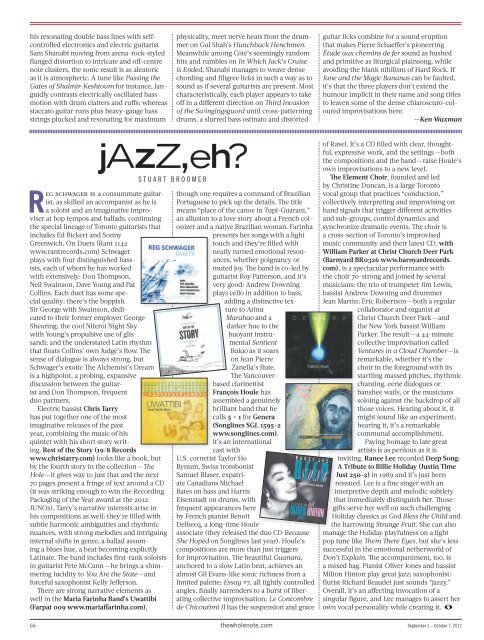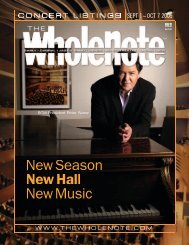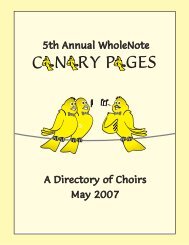PDF Version
PDF Version
PDF Version
- No tags were found...
Create successful ePaper yourself
Turn your PDF publications into a flip-book with our unique Google optimized e-Paper software.
his resonating double bass lines with selfcontrolledelectronics and electric guitaristSam Shanabi moving from arena-rock-styledflanged distortion to intricate and off-centrenote clusters, the sonic result is as aleatoricas it is atmospheric. A tune like Passing theGates of Shalmir-Keshtoum for instance, languidlycontrasts electrically oscillated bassmotion with drum clatters and ruffs; whereasstaccato guitar runs plus heavy-gauge bassstrings plucked and resonating for maximumphysicality, meet nerve beats from the drummeron Gul Shah’s Hunchback Henchmen.Meanwhile among Côté’s seemingly randomhits and rumbles on In Which Jack’s Cruiseis Ended, Shanabi manages to weave densechording and filigree licks in such a way as tosound as if several guitarists are present. Mostcharacteristically, each player appears to takeoff in a different direction on Third Invasionof the Swingingsguord until cross-patterningdrums, a slurred bass ostinato and distortedguitar licks combine for a sound eruptionthat makes Pierre Schaeffer’s pioneeringÉtude aux chemins de fer sound as hushedand primitive as liturgical plainsong, whileavoiding the blank nihilism of Hard Rock. IfJane and the Magic Bananas can be faulted,it’s that the three players don’t extend thehumour implicit in their name and song titlesto leaven some of the dense chiaroscuro-colouredimprovisations here.—Ken WaxmanReg schwager is a consummate guitarist,as skilled an accompanist as he isa soloist and an imaginative improviserat bop tempos and ballads, continuingthe special lineage of Toronto guitarists thatincludes Ed Bickert and SonnyGreenwich. On Duets (Rant 1142www.rantrecords.com) Schwagerplays with four distinguished bassists,each of whom he has workedwith extensively: Don Thompson,Neil Swainson, Dave Young and PatCollins. Each duet has some specialquality: there’s the boppishSir George with Swainson, dedicatedto their former employer GeorgeShearing; the cool Niterói Night Skywith Young’s propulsive use of glissandi;and the understated Latin rhythmthat floats Collins’ own Judge’s Row. Thesense of dialogue is always strong, butSchwager’s exotic The Alchemist’s Dreamis a highpoint, a probing, expansivediscussion between the guitaristand Don Thompson, frequentduo partners.Electric bassist Chris Tarryhas put together one of the mostimaginative releases of the pastyear, combining the music of hisquintet with his short story writing.Rest of the Story (19/8 Recordswww.christarry.com) looks like a book, butby the fourth story in the collection — TheHole — it gives way to just that and the next70 pages present a fringe of text around a CD(it was striking enough to win the RecordingPackaging of the Year award at the 2012JUNOs). Tarry’s narrative interests arise inhis compositions as well: they’re filled withsubtle harmonic ambiguities and rhythmicnuances, with strong melodies and intriguinginternal shifts in genre, a ballad assuminga blues hue, a beat becoming explicitlyLatinate. The band includes first-rank soloistsin guitarist Pete McCann — he brings a shimmeringlucidity to You Are the State — andforceful saxophonist Kelly Jefferson.There are strong narrative elements aswell in the Maria Farinha Band’s Uwattibi(Farpat 009 www.mariaffarinha.com),STUART BROOMERthough one requires a command of BrazilianPortuguese to pick up the details. The titlemeans “place of the canoe in Tupi-Guarani,”an allusion to a love story about a French colonizerand a native Brazilian woman. Farinhapresents her songs with a lighttouch and they’re filled withneatly turned emotional resonances,whether poignancy ormuted joy. The band is co-led byguitarist Roy Patterson, and it’svery good: Andrew Downingplays cello in addition to bass,adding a distinctive textureto AtinaMarahao and adarker hue to thebuoyant instrumentalSentientBaiao as it soarson Jean PierreZanella’s flute.The VancouverbasedclarinettistFrançois Houle hasassembled a genuinelybrilliant band that hecalls 5 + 1 for Genera(Songlines SGL 1595-2www.songlines.com).It’s an internationalcast withU.S. cornetist Taylor HoBynum, Swiss trombonistSamuel Blaser, expatriateCanadians MichaelBates on bass and HarrisEisenstadt on drums, withfrequent appearances hereby French pianist BenoîtDelbecq, a long-time Houleassociate (they released the duo CD BecauseShe Hoped on Songlines last year). Houle’scompositions are more than just triggersfor improvisation. The beautiful Guanara,anchored to a slow Latin beat, achieves analmost Gil Evans-like sonic richness from alimited palette; Essay #7, all tightly controlledangles, finally surrenders to a burst of liberatingcollective improvisation; Le Concombrede Chicoutimi II has the suspension and graceof Ravel. It’s a CD filled with clear, thoughtful,expressive work, and the settings — boththe compositions and the band — raise Houle’sown improvisations to a new level.The Element Choir, founded and ledby Christine Duncan, is a large Torontovocal group that practices “conduction,”collectively interpreting and improvising onhand signals that trigger different activitiesand sub-groups, control dynamics andsynchronize dramatic events. The choir isa cross-section of Toronto’s improvisedmusic community and their latest CD, withWilliam Parker at Christ Church Deer Park(Barnyard BR0326 www.barnyardrecords.com), is a spectacular performance withthe choir 70-strong and joined by severalmusicians: the trio of trumpeter Jim Lewis,bassist Andrew Downing and drummerJean Martin; Eric Robertson — both a regularcollaborator and organist atChrist Church Deer Park — andthe New York bassist WilliamParker. The result — a 44-minutecollective improvisation calledVentures in a Cloud Chamber — isremarkable, whether it’s thechoir in the foreground with itsstartling massed pitches, rhythmicchanting, eerie dialogues orbanshee wails, or the musicianssoloing against the backdrop of allthose voices. Hearing about it, itmight sound like an experiment;hearing it, it’s a remarkablecommunal accomplishment.Paying homage to late greatartists is as perilous as it isinviting. Ranee Lee recorded Deep Song:A Tribute to Billie Holiday (Justin TimeJust 250-2) in 1989 and it’s just beenreissued. Lee is a fine singer with aninterpretive depth and melodic subtletythat immediately distinguish her. Thosegifts serve her well on such challengingHoliday classics as God Bless the Child andthe harrowing Strange Fruit. She can alsomanage the Holiday playfulness on a lightpop tune like Them There Eyes, but she’s lesssuccessful in the emotional netherworld ofDon’t Explain. The accompaniment, too, isa mixed bag. Pianist Oliver Jones and bassistMilton Hinton play great jazz; saxophonist/flutist Richard Beaudet just sounds “jazzy.”Overall, it’s an affecting invocation of asingular figure, and Lee manages to assert herown vocal personality while creating it.66 thewholenote.com September 1 – October 7, 2012
















